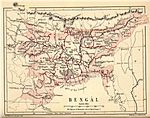Kingdom of Bhulua ভুলুয়া রাজ্য | |||||||||
|---|---|---|---|---|---|---|---|---|---|
| 1203–1613 | |||||||||
| Capital | Kalyanpur Bhulua | ||||||||
| Recognised national languages | Magadhi Prakrit | ||||||||
| Recognised regional languages | Noakhailla | ||||||||
| Religion | Hinduism | ||||||||
| Government | Monarchy | ||||||||
| Raja | |||||||||
• 1203 | Bishwambhar Sur (first) | ||||||||
• c. 1600 | Ananta Manikya (last ruler under Tripura vassalage) | ||||||||
• 1728 | Kirti Narayan (zamindar) | ||||||||
| Chief Minister | |||||||||
• 1600s | Mirza Yusuf Barlas | ||||||||
| Historical era | Classical period | ||||||||
• Established | 1203 | ||||||||
• Disestablished | 1613 | ||||||||
| |||||||||
| Today part of | Bangladesh | ||||||||
| History of Bangladesh |
|---|
 |
|
|
| History of Bengal |
|---|
 |
The Kingdom of Bhulua (Bengali: ভুলুয়া রাজ্য, romanized: Bhulua Rajjo) was a kingdom and later a zamindari covering the present-day Noakhali region of Bangladesh. According to local tradition the establishment of the kingdom dates from the twelfth century, when Bishwambhar Sur, ninth son of Adi Sur, a Kshatriya of Mithila who passed by the area during a pilgrimage. There are several versions of this tale and questions about the accuracy of the date, but it is probably a fact that the early Rajas of Bhulua were Kayasthas from Western Bengal. The kingdom fell under Tripura vassalage in the 15th century, and was reduced to a zamindari (fiefdom) after losing to the Mughals. Most of the kingdom's land has been eroded by the Meghna River.[1]
- ^ Husne Jahan, Shahnaz (2012). "Laksmana Manikya". In Sirajul Islam; Miah, Sajahan; Khanam, Mahfuza; Ahmed, Sabbir (eds.). Banglapedia: the National Encyclopedia of Bangladesh (Online ed.). Dhaka, Bangladesh: Banglapedia Trust, Asiatic Society of Bangladesh. ISBN 984-32-0576-6. OCLC 52727562. OL 30677644M. Retrieved 17 November 2024.
